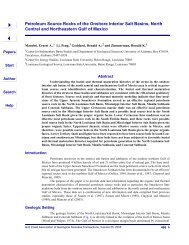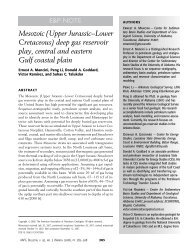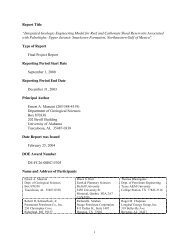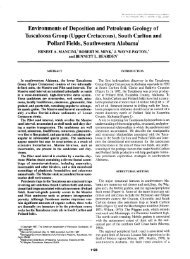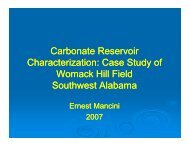Part 4 - Berg - Hughes Center
Part 4 - Berg - Hughes Center
Part 4 - Berg - Hughes Center
You also want an ePaper? Increase the reach of your titles
YUMPU automatically turns print PDFs into web optimized ePapers that Google loves.
northwest. These sandstones accumulated on the shelf where they were subsequently<br />
reworked. Kornfeld (1985) stated that proximal destructive delta systems existed in<br />
northern Louisiana and northeastern Texas and that another system consisting of barrier<br />
beaches and bars was located centrally between them.<br />
Environments of deposition located landward from the open Gulf to the south and<br />
paralleling the late Jurassic Gulf of Mexico coastline included a longshore barrier island<br />
in northern Louisiana and a coastal lagoon in southern Arkansas. Sands to the barrier<br />
island were supplied by a delta that was formed by the ancestral Mississippi River in<br />
northeastern Louisiana and adjacent Mississippi (Thomas and Mann, 1966). The<br />
description by these authors and others of the open and shallow marine systems together<br />
with the nearshore coastal features typify the lithofacies of the formations within the<br />
Cotton Valley Group. Updip in southern Arkansas, the uppermost Schuler Formation<br />
pinches out. Of interest are the thick downdip marine deposits in northern Louisiana that<br />
include the following formations: Bossier Shale, Terryville Sandstone, Hicos Shale,<br />
Knowles Limestone, and Schuler Formation. The sedimentary characteristics of the<br />
formations that comprise the group in northern Louisiana are summarized below.<br />
Bossier Shale (Millerton Formation)<br />
The open marine basin deposits of the Bossier Shale are found in northern Louisiana<br />
and consist of dark-gray, fossiliferous, calcareous shale. A wedge of this marine shale<br />
pinches out updip in southernmost Arkansas. It attains a maximum thickness of 2,000 ft<br />
(610 m). The marine shale grades eastward into red shale and sandstone in northeastern<br />
Louisiana (Swain, 1944; Forgotson, 1954). The Haynesville Formation conformably<br />
underlies the Bossier; and where the Haynesville is absent, the Bossier rests on the<br />
357




